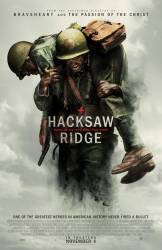Factual error: Throughout the battle scenes on the ridge, the machine gunners can be seen picking up the guns to fire on the move. While not impossible, not as painless as it is made to appear. The M1919 .30 caliber air cooled machine gun was light enough to carry. But for the gunner to hold an already hot barrel and continue firing would have been extremely painful without the issued heat retardant mitten or the barrel "hoop" w/ wooden handle. These fixes allowed the gun to be fired on the move and saved many from having their palms burned and scarred for life.
Suggested correction: They have barrel shrouds which dissipate the heat and allow a grip...they are not in contact with the barrel.
Factual error: When Desmond's father is in his WW1 uniform, to the far right he is wearing a French Croix de Guerre (Cross of War) - the medals themselves are identical however, this decoration incorrectly hangs from a WW2 type ribbon.
Factual error: Once the men first climb up to "Hacksaw Ridge," the camera pans over numerous corpses. One of them has an M1 Helmet lying on its top to where the liner is seen. The liner has the web suspension straps cross each other instead of being tied in the center. This means the liner is a Vietnam era type, and not World War II.
Factual error: When Sergeant Howell is first introduced, the corporal assisting him calls the barracks to attention. You do not call "attention" for an NCO, however - you call "at ease."
Suggested correction: They are in boot camp. You stand at attention when they say you stand at attention. Especially when your Drill Sergeant walks in.
This is absolutely incorrect. In the United States Army, soldiers stand "at ease" in the presence of a non-commissioned officer (such as a drill sergeant). Soldiers only stand at "attention" when in formation or in the presence of a commissioned officer. Having served, I am very well acquainted with the appropriate procedure.
Suggested correction: When you are in basic training, if you are called to attention you come to attention...if you are told to bend over and scratch your 6, you do just that...these men are not yet soldiers.
Factual error: Some of the men (including Desmond) are seen using modern, reproduction canteens. They have metal wire chains while World War II ones use stamped ones and a silicon or rubber disk in the cap instead of a cork.
Factual error: The soldiers somehow have cool looking, perfectly fitting dress uniforms, on the day of their enlistment or before they've gone to boot camp. Not something they've have so quickly.
Factual error: When the Japanese commander is committing seppuku near the end of the final battle, after he makes the first cut his second cuts his head clean off, and it can be seen falling to the ground in front of his body. While having a second perform this act was indeed commonly part of the ritual, the second was actually supposed to ensure that the neck was not cut cleanly through, i.e. He was supposed to stop short and leave the head attached to the body by a small flap of tissue. It was considered extremely undignified and unnecessarily messy for the head to come clean off and roll around on the ground. For that reason, it was important to choose a second who was a skilled swordsman.
Suggested correction: While factually you are correct, s**t happens...when does anything in war go as it's supposed to? Just because something is supposed to go a certain way and doesn't, doesn't mean it was a mistake in the filming.
Factual error: In the courtroom scene, The Judge (Philip Quast) wears the Legion of Merit ribbon in the Commander Grade (Crimson ribbon with silver gold bow-knot (rosette)) left of the purple heart ribbon. However, the Legion of Merit is only authorized for u.s. Servicemembers in the Legionnaire Degree (plain ribbon with no markers). The only US exception to this were Gen. Lyman L. Lemnitzer and 59 other officers who received the degree of Officer (gold rosette on ribbon), still a lesser degree than Commander.





